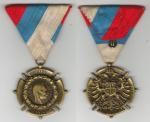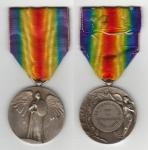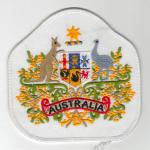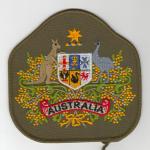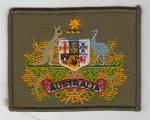-
Posts
1,170 -
Joined
-
Last visited
-
Days Won
1
Content Type
Profiles
Forums
Blogs
Gallery
Events
Store
Everything posted by RobW
-

Greece - Help please ID Ribbon bar
RobW replied to Noor's topic in Southern European & Balkan States
Hello Nicholas, If such a Greek group was awarded where would the foreign awards, (French Croix de Guerre or Serbian Milosh Obilich medal) be mounted? Would they go at the end of all the Greek awards and then if so, would a personal valour award like the Milosh Obilich medal come before the French Croix de Guerre, which was also awarded at different Regimental, Corps etc... levels? Did the Greek military 'court mount' there medals as I have seen some groups so mounted with others the medals were swing mounted. Regards, Rob -

American (US) Victory Medals
RobW replied to Kev in Deva's topic in Inter-Allied Victory Medals of the Great War
Hello Tim, Yes you are indeed right. These clasps closely resemble other repro clasp types that have been attributed by Mr Laslo to the firm of Bailey, Banks & Biddle. I am pretty confident that these middle clasps are B,B, & B. What intrigues me more is the identity and manufacturer of the top MONTDIDIER-NOYON clasp. Regards, Rob -

Italian Victory Medals
RobW replied to Kev in Deva's topic in Inter-Allied Victory Medals of the Great War
Hello Tim, No; the Italian repro type 3 came from a fellow forum member! I obtained it recently from an FJP Auction and am very happy with the piece. I now have a couple of the italian repro type 3. It is always handy to have spares in case of trades etc... Regards, Rob -

Serbia Serbia - Different Types of Commemorative WWI
RobW replied to love4history's topic in Southern European & Balkan States
To all, The shallow cardboard box is a pale blue colour with the dates imprinted vertically down the box lid. Other French boxes have been seen with the dates printed horizontally across the middle. Regards, Rob -

Serbia Serbia - Different Types of Commemorative WWI
RobW replied to love4history's topic in Southern European & Balkan States
To all, Here is another World War 1 Commemorative Medal produced in France. It is different from the specimen posted at #15 insofar as it has a much lighter tone, the oval suspension ring is brass instead of the narrower silver coloured one, and has a slightly coarser ribbon. On the reverse the tri-fold ribbon ring hole is higher to accommodate the more oval shaped suspension ring. Box pics to follow. Regards, Rob -

Serbia Serbia - Different Types of Commemorative WWI
RobW replied to love4history's topic in Southern European & Balkan States
Thanks Sasa, I mainly collect the Interallied Victory medal series but also have an interest in some other related Great War medals, including Serbian items. Regards, Rob -

Italian Victory Medals
RobW replied to Kev in Deva's topic in Inter-Allied Victory Medals of the Great War
Hello Tim and all, Back to the medals here are some pics of an italian repro type 3. While not evident in this pic the medal is considerably lighter in finish than the usual darker bronze of the unofficial type 1, and is of a similar finish as the example posted in #76 of this thread. As can be seen there are minor reverse die variations compared to the unofficial type 1. Regards, Rob -

American (US) Victory Medals
RobW replied to Kev in Deva's topic in Inter-Allied Victory Medals of the Great War
Hello Tim, The hubs that the U.S mint provided to: Art Metal Works, Jos Mayer, and S.G. Adams were subsequently used to produce their dies which where then used to press the battle and service clasps. I wouldn't expect to see too much variation in these official clasps although there have been minor variations observed in lettering, spacing etc... A close look at some official bars will see that they have been simply produced without the usually seen spacers, although there have been examples seen where the spacers were actually cut off leaving evidence of the modification. I have also seen an official DEFENSIVE SECTOR bar with spacers, where it was usually produced without, so I don't think we should be altogether surprised when minor variations are seen. Back to the 2 middle clasps. A close look at them shows that the end semi-circles are completely flat even under a glass, so it certainly looks like a design feature and not as a result of a poor moulding or die flaw. Regards, Rob -

American (US) Victory Medals
RobW replied to Kev in Deva's topic in Inter-Allied Victory Medals of the Great War
Tim, You would be correct in assuming that there are no major differences, other than the lack of spacers, between the two sets of clasps in your pics. The official clasps, as produced by the 3 major manufacturers, were all made with the hubs provided by the U.S. mint, hence there should be no major changes. The official clasps are also seen on occasion with no spacers as per your right example. If you note the ST. MIHIEL & MEUSE-ARGONNE clasps in my post you will see not only are the end semi-circles completely filled in but the stars are actually upside down or off-centre. This indicates another producer. I have not yet taken the clasps off the medal so can't verify if there are any reverse markings. A similar clasp named ALSACE-LORRAINE, with filled in edge semi-circles, and upside down or off-centre stars, is also illustrated in Mr Laslo's book, 2nd Edition, page 119. Regards, Rob -

American (US) Victory Medals
RobW replied to Kev in Deva's topic in Inter-Allied Victory Medals of the Great War
Hello Tim, The lack of a proper semi-circle, as for the ST. MIHIEL & MEUSE-ARGONNE clasps has been seen on some other reproduction clasps produced by the firm of Bailey, Banks, & Biddle although they have much smaller stars. One of these is also illustrated in Mr Laslo's 2nd Edition. As for the LYS clasp I have seen numerous other examples of the same dimensions, font, and end semi-circles of Navy clasps that have FRANCE impressed on the back of the clasp. This indicates that they date from the 1920's as those inscribed with 'MADE IN FRANCE' on the back of the clasp did not come out until early in the 1930's. Regards, Rob -

American (US) Victory Medals
RobW replied to Kev in Deva's topic in Inter-Allied Victory Medals of the Great War
To all, As part of a related project I am researching some varieties of U.S. victory medal battle clasps. Illustrated is a U.S. vic with a number of reproduction clasps where I am attempting to identify the period of manufacture and the actual manufacturing firm. * LYS clasp - It has no spacers and is slightly wider than the official clasp with a different gap at the semi-circle on the end. I believe it was produced by a French manufacturer. * ST. MIHIEL & MEUSE-ARGONNE clasps - These two again have no spacers, and have filled in end semi-circles and a sans serif font that differs from the font on the official clasp. While there are other similar type clasp with much smaller stars, I do not believe these two bars are of French manufacture. Of note is the off-centre strike of the stars on the clasps. * DEFENSIVE SECTOR - Standard official clasp. Any assistance, especially from our U.S. vic collectors, would be greatly appreciated in identifying the background and details of these clasps. Regards, Rob -

French Victory Medals
RobW replied to Kev in Deva's topic in Inter-Allied Victory Medals of the Great War
To all, Here is a French unofficial type 2 in silvered-bronze. Not common or seen that often. It has the correct hallmark and BRONZE impressed on the planchet edge. Regards, Rob -

British Victory Medals
RobW replied to Kev in Deva's topic in Inter-Allied Victory Medals of the Great War
Hello JM, While each of the contributing Commonwealth nations that answered the call of Great Britiain and provided troops etc...for the war effort were as important as the next it would be a bold person to suggest specific individual Regiments from those countries. Such a suggestion could be interpreted as bias. Each collector would inevitably have their own particular area or Regiment of interest and even dealers are similarly inclined. If you were in an Indian Gurkha Regiment you would look to obtain such a specimen, if you were a Scott you would look to obtain a vic from any of the Highland or Lowland Divisions, and so on... I feel that to attempt to obtain a representative group of vics from each country would be a big task in itself. I would suggest you do some more research on the contributing Divisions from each country and choose a Regiment which interests you. There are a staggering number of different Regiments to choose from so there will be many options of choice. If you look at http://www.1914-1918.net/ it does provide an Order Of Battle with details on these Commonwealth Divisions. I hope this has helped. Regards, Rob -

Romania Romania - award certificates in WWII
RobW replied to Carol I's topic in Central & Eastern European States
Hello Carol I, I only have Great War certificates for the victory medal so that won't be of much help to you. Good luck in your continued search. Regards, Rob -

British Victory Medals
RobW replied to Kev in Deva's topic in Inter-Allied Victory Medals of the Great War
Hello JM, I am not sure what you mean by 'bogus' UK vic but I would suggest it is harder to fake or create a fantasy group as Great Britain vics, and Commonwealth medals are generally issued named. Hence it would be relatively easy to check the recipients medal entitlement. If another medal, named to a different person showed up in a group it would be discounted and suspect. There are of course exceptions with official re-naming due to original naming errors but something as obvious as another persons details would be immediately noticed. There is a practice where medals are 'name erased'. In these cases the details of the original recipient are removed by filing leaving a 'clean medal'. It is again relatively easy to spot these re-named items as the edge has a curved appearance and not flat and the medal circumference is a bit narrower where the filing has been done. In some cases these name erased items are used to complete a group where the originals have been split, and an unnamed original is not available, but it has also been seen where certain vendors have been known to insert other renamed or unnamed originals into a group to increase the price etc... Unnamed as issued Great Britain vics are in the market although they are not that common. Unnamed examples of the South African victory are also infrequently seen as it was produced in London and then shipped to South Africa unnamed for later naming and awarding. As far as the ribbon is concerned there is a particular style and shade of Great Britain vic ribbon. It is wider at 38 mm and has a thin white edging. Examples of this ribbon has been posted previously on this thread in Great Britain groups (post #161) as well as the corresponding ribbon bar (post # 174). Once the medals are mounted, either swing mounted (posts #85 & #161), or court mounted (post #107) the ribbon is fixed and can't be tampered with without evidence of it having being changed. I hope this has helped in some way to answer the question. Regards, Rob -

American (US) Victory Medals
RobW replied to Kev in Deva's topic in Inter-Allied Victory Medals of the Great War
Here is the box. Art Metal Works, Inc. It has the clasp names on the exterior in purple ink and the contract date in March 1920. Note that even though the box states 'Unassembled with pin' the medal did in fact come with all clasps and brooch attached correctly. Regards, Rob -

American (US) Victory Medals
RobW replied to Kev in Deva's topic in Inter-Allied Victory Medals of the Great War
To one and all, Last post for a bit as other commitments press. Still on the subject of boxes here is a U.S. vic with 4 clasps (4th Div), with its corresponding box. Box picture to follow. Regards, Rob -

American (US) Victory Medals
RobW replied to Kev in Deva's topic in Inter-Allied Victory Medals of the Great War
Hello JM, The perennial problem of any vic collector, especially for those nations that do not by routine issue their medals named, is attempting to conduct research on the individuals awarded the items. While U.S. service medals (in this case the vic) were generally issued unnamed there are numerous examples where the recipient has had the medal privately engraved. I have seen examples named to both Navy as well as an Army member. Some have been seen named in block capitals or script on the rim, while other examples have been seen with the engraving on the reverse. Despite the specific combination of clasps, in this case with the medal unnamed it would be difficult to actually pin it to a specific recipient unless it also came with any associated award paperwork, service records, and maybe a State award. Unless there is specific information to indicate provenance, including the award of the Silver Citation Star, it will be quite difficult to accurately determine the recipient. I think anything else would be a bit speculative or supposition. Regards, Rob -

American (US) Victory Medals
RobW replied to Kev in Deva's topic in Inter-Allied Victory Medals of the Great War
Tim, Totally agree and couldn't have said it better myself. Regards, Rob -

American (US) Victory Medals
RobW replied to Kev in Deva's topic in Inter-Allied Victory Medals of the Great War
Tim, Agree that medals that were issued as part of late claims, replacements etc... would be more likely to have a combination of original backstrap type and push-pin clasps as per your example. I also have a U.S. re-issue type 3 vic, with the tab suspender, produced in an early 1980s contract that also has 4 re-issue clasps; 2 of the darker bronze variety and the alternating 2 in a more shiny bronze variety. If I can find it in a reasonably short time I will dig it out and post a pic. I hope this helps. Regards, Rob -

American (US) Victory Medals
RobW replied to Kev in Deva's topic in Inter-Allied Victory Medals of the Great War
Tim, The Army QM Department ordered a sufficient quantity of clasps based on the expected number of claims for such clasps which, in itself, was based on the expected qualifying soldiers at the various engagements. Some information has indicated that these quantities were over estimated at the time which resulted in large stock holdings. Another re-assessment was conducted in 1949 to cover the expected ratio of replacements, re-issues, lost medals etc over the coming decades and the remainder of the clasps deemed surplus were remelted. It was only when these final original stocks, with slide on backstraps, were exhausted that the Army QM Department started using the re-issue clasps with push through pins. As far as I have been able to determine this re-issuing of medals with individual push-pin clasps started to occur in the early 1980s. These re-issues have been seen in both engagment and service (country) clasps and have also had a dark bronze finish (in your example) as well as a shiny bronze finish with the tops of the letters slightly burnished as a contrast. Regards, Rob -

American (US) Victory Medals
RobW replied to Kev in Deva's topic in Inter-Allied Victory Medals of the Great War
Hello Tim & JM, This is off the top of the head as I don't have any of my references nearby. There was only a limited number of engagement clasps originally authorised and this list was expanded in due course with the end result being 13 actual battle or engagement clasps. The 'Defensive Sector' clasp was authorised, in part to recognise those that hadn't actually participated in an authorised engagement yet were deemed worthy of recognition for their defensive (holding the line) efforts, to negate the necessity of authorising the 'First Army' and 'Second Army' clasps which was also mooted at the time, as well as service in Russia / Siberia etc... All of this initial qualifying work was occurring before the contracts were let for the production of the Army medals. As can be seen from the contract date on the boxes the actual manufacturing contract did not occur until March of 1920. Additionally all authorised engagement clasps combinations and the final list of qualifying units, regiments, etc was still being finalised as the Army Orders pertaining to those qualifying units was not completed until much after this first initial contract run. Having said all of that it is therefore not unusual to see boxes with the words 'Unassembled with pin' on them as they also have the contract date of March 1920. I have seen quite a few examples of this and the box actaully contains the medal, fully assembled with appropriate clasps and brooch. In fact if you look closely at all the boxes from the 3 major manufacturers you will also observe that they all have the same contract number and date. Regards, Rob



